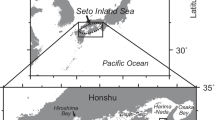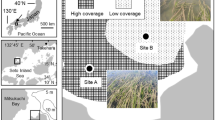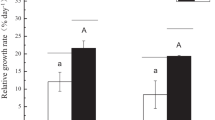Abstract
Continuous accumulation of fossil CO2 in the atmosphere and increasingly dissolved CO2 in seawater leads to ocean acidification (OA), which is known to affect phytoplankton physiology directly and/or indirectly. Since increasing attention has been paid to the effects of OA under the influences of multiple drivers, in this study, we investigated effects of elevated CO2 concentration under different levels of light and nutrients on growth rate, particulate organic (POC) and inorganic (PIC) carbon quotas of the coccolithophorid Emiliania huxleyi. We found that OA treatment (pH 7.84, CO2 = 920 μatm) reduced the maximum growth rate at all levels of the nutrients tested, and exacerbated photo-inhibition of growth rate under reduced availability of phosphate (from 10.5 to 0.4 μmol l−1). Low nutrient levels, especially lower nitrate concentration (8.8 μmol l−1 compared with 101 μmol l−1), decreased maximum growth rates. Nevertheless, the reduced levels of nutrients increased the maximum PIC production rate. Decreased availability of nutrients influenced growth, POC and PIC quotas more than changes in CO2 concentrations. Our results suggest that reduced nutrient availability due to reduced upward advective supply because of ocean warming may partially counteract the negative effects of OA on calcification of the coccolithophorid.




Similar content being viewed by others
References
Bach, L. T., U. Riebesell & K. G. Schulz, 2011. Distinguishing between the effects of ocean acidification and ocean carbonation in the coccolithophore Emiliania huxleyi. Limnology and Oceanography 56: 2040–2050.
Bach, L. T., U. Riebesell, M. A. Gutowska, L. Federwisch & K. G. Schulz, 2015. A unifying concept of coccolithophore sensitivity to changing carbonate chemistry embedded in an ecological framework. Progress in Oceanography 135: 125–138.
Beardall, J., S. Roberts & J. A. Raven, 2005. Regulation of inorganic carbon acquisition by phosphorus limitation in the green alga Chlorella emersonii. Canadian Journal of Botany 83: 859–864.
Behrenfeld, M., R. O’Malley, D. Siegel, C. McClain, J. Sarmiento, G. Feldman, A. Milligan, P. Falkowski, R. Letelier & E. Boss, 2006. Climate-driven trends in contemporary ocean productivity. Nature 444: 752–755.
Borchard, C., A. V. Borges, N. Händel & A. Engel, 2011. Biogeochemical response of Emiliania huxleyi (PML B92/11) to elevated CO2 and temperature under phosphorous limitation: a chemostat study. Journal of Experimental Marine Biology and Ecology 410: 61–71.
Boyd, P. W., S. T. Lennartz, D. M. Glover & S. C. Doney, 2015. Biological ramifications of climate-change-mediated oceanic multi-stressors. Nature Climate Change 5: 71–79.
Boyd, P. W., P. W. Dillingham, C. M. McGraw, E. A. Armstrong, C. E. Cornwall, F. F. Feng, C. L. Hurd, M. Gault-Ringold, M. Y. Roleda, E. Timmins-Schiffman & B. L. Nunn, 2016. Physiological responses of a Southern Ocean diatom to complex future ocean conditions. Nature Climate Change 6: 207–213.
Boyd, P. W., S. Collins, S. Dupont, K. Fabricius, J. P. Gattuso, J. Havenhand, D. A. Hutchins, U. Riebesell, M. S. Rintoul, M. Vichi, H. Biswas, A. Ciotti, K. Gao, M. Gehlen, C. L. Hurd, H. Kurihara, C. M. McGraw, J. M. Navarro, G. E. Nilsson, U. Passow & H. O. Pörtner, 2018. Experimental strategies to assess the biological ramifications of multiple drivers of global ocean change—a review. Global Change Biology 24: 1–23.
Brennan, G. & S. Colllins, 2015. Growth responses of a green alga to multiple environmental drivers. Nature Climate Change 5: 892–897.
Bruhn, A., J. LaRoche & K. Richardson, 2010. Emiliania huxleyi (Prymnesiophyceae): nitrogen-metabolism genes and their expression in response to external nitrogen sources. Journal of Phycology 46: 266–277.
Caldeira, K. & M. E. Wickett, 2003. Oceanography: anthropogenic carbon and ocean pH. Nature 425: 365.
Chen, X. & K. Gao, 2003. Effect of CO2 concentrations on the activity of photosynthetic CO2 fixation and extracelluar carbonic anhydrase in the marine diatom Skeletonema costatum. Chinese Science Bulletin 48: 2616–2620.
Chou, W. C., D. D. Sheu, C. A. Chen, S. L. Wang & C. M. Tseng, 2005. Seasonal variability of carbon chemistry at the SEATS time-series site, Northern South China Sea betweeen 2002 and 2003. Terrestrial Atmospheric and Oceanic Sciences 16: 445–465.
Cloern, J. E., 1999. The relative importance of light and nutrient limitation of phytoplankton growth: a simple index of coastal ecosystem sensitivity to nutrient enrichment. Aquatic Ecology 33: 3–16.
Dickson, A. G., 1993. pH buffers for sea water media based on the total hydrogen ion concentration scale. Deep Sea Research 40: 107–118.
Dickson, A. G., J. D. Afghan & G. C. Anderson, 2003. Reference materials for oceanic CO2 analysis: a method for the certification of total alkalinity. Marine Chemistry 80: 185–197.
Dyhrman, S. T. & B. Palenik, 2003. Characterization of ectoenzyme activity and phosphate-regulated proteins in the coccolithophorid Emiliania huxleyi. Journal of Plankton Research 25: 1215–1225.
Eilers, P. & J. Peeters, 1988. A model for the relationship between light intensity and the rate of photosynthesis in phytoplankton. Ecological Modelling 42: 199–215.
Feng, Y. Y., M. E. Warner, Y. H. Zhang, J. Sun, F. X. Fu, J. M. Rose & D. A. Hutchins, 2008. Interactive effects of increased pCO2, temperature and irradiance on the marine coccolithophore Emiliania huxleyi (Prymnesiophyceae). European Journal of Phycology 43: 87–98.
Feng, Y. Y., M. Y. Roleda, E. Armstrong, P. W. Boyd & C. L. Hurd, 2017. Environmental controls on the growth, photosynthetic and calcification rates of a Southern Hemisphere strain of the coccolithophore Emiliania huxleyi. Limnology and Oceanography 62: 519–540.
Finkel, Z. V., 2001. Light absorption and size scaling of light-limited metabolism in marine diatoms. Limnology and Oceanography 46: 86–94.
Gafar, N. A., B. D. Eyre & K. G. Schulz, 2018. A conceptual model for projecting coccolithophorid growth, calcification and photosynthetic carbon fixation rates in response to global ocean change. Frontiers in Marine Science 4: 433.
Gao, K. S., J. T. Xu, G. Gao, Y. H. Li, D. A. Hutchins, B. Q. Huang, L. Wang, Y. Zheng, P. **, X. N. Cai, D. P. Häder, W. Li, K. Xu, N. N. Liu & U. Riebesell, 2012a. Rising CO2 and increased light exposure synergistically reduce marine primary productivity. Nature Climate Change 2: 519–523.
Gao, K., E. W. Helbling, D. P. Häder & D. A. Hutchins, 2012b. Responses of marine primary producers to interactions between ocean acidification, solar radiation, and warming. Marine Ecology Progress Series 470: 167–189.
Geider, R. J., H. L. MacIntyre & T. M. Kana, 1997. A dynamic model of phytoplankton growth and acclimation: responses of the balanced growth rate and chlorophyll a: carbon ratio to light, nutrient-limitation and temperature. Marine Ecology Progress Series 148: 187–200.
Hansen, H. P. & F. Koroleff, 1999. Determination of nutrients. In Grasshoff, K., K. Kremling & M. Ehrhardt (eds), Methods of Seawater Analysis. Wiley, New Yrok: 159–228.
Harrison, W. G. & W. K. W. Li, 2008. Phytoplankton growth and regulation in the Labrador Sea: light and nutrient limitation. Journal of Northwest Atlantic Fishery Science 39: 71–82.
Hoffmann, R., C. Kirchlechner, G. Langer, A. S. Wochnik, E. Griesshaber, W. W. Schmah & C. Scheu, 2015. Insight into Emiliania huxleyi coccospheres by focused ion beam sectioning. Biogeosciences 12: 825–834.
Hutchins, D. A. & F. X. Fu, 2017. Microorganisms and ocean global change. Nature Microbiology 2: 17058.
**, P., J. Ding, T. **ng, U. Riebesell & K. Gao, 2017. High levels of solar radiation offset impacts of ocean acidification on calcifying and non-calcifying strains of Emiliania huxleyi. Marine Ecology Progress Series 568: 47–58.
Kim, H. S., S. J. Hwang, J. K. Shin, K. G. An & C. G. Yoon, 2007. Effects of limiting nutrients and N: P ratios on the phytoplankton growth in a shallow hypertrophic reservoir. Hydrobiologia 581: 255–267.
Kottmeier, D. M., S. D. Rokitta & B. Rost, 2016. Acidification, not carbonation, is the major regulator of carbon fluxes in the coccolithophore Emiliania huxleyi. New Phytologist 211: 126–137.
Langer, G., G. Nehrke, I. Probert, J. Ly & P. Ziveri, 2009. Strain-specific responses of Emiliania huxleyi to changing seawater carbonate chemistry. Biogeosciences 6: 2637–2646.
Langer, G., K. Oetjen & T. Brenneis, 2013. Coccolithophores do not increase particulate carbon production under nutrient limitation: a case study using Emiliania huxleyi (PML92/11). Journal of Experimental Marine Biology and Ecology 443: 155–161.
Larsen, A., G. A. F. Flaten, R. Sandaa, T. Castberg, R. Thyrhaug, S. R. Erga, S. Jacquet & G. Bratbak, 2004. Spring phytoplankton bloom dynamics in Norwegian coastal waters: microbial community succession and diversity. Limnology and Oceanography 49: 180–190.
Leonardos, N. & R. J. Geider, 2005. Eleveted atmospheric carbon dioxide increases organic carbon fixation by Emiliania huxleyi (Haptophyta), under nutrient-limited high-light conditions. Journal of Phycology 41: 1196–1203.
Matthiessen, B., S. L. Eggers & S. A. Krug, 2012. High nitrate to phosphorus regime attenuates negative effects of rising pCO2 on total population carbon accumulation. Biogeosciences 9: 1195–1203.
McKew, B. A., P. Davey, S. J. Finch, J. Hopkins, S. C. Lefebvre, M. V. Metodiev, K. Oxborough, C. A. Raines, T. Lawso & R. J. Geider, 2013. The trade-off between the light-harvesting and photoprotective functions of fucoxanthin-chlorophyll proteins dominates light acclimation in Emiliania huxleyi (clone CCMP 1516). New Phytologist 200: 74–85.
McKew, B. A., G. Metodieva, C. A. Raines, M. V. Metodier & R. J. Geider, 2015. Acclimation of Emiliania huxleyi (1516) to nutrient limitation involves precise modification of the proteome to scavenge alternative sources of N and P. Environmental Microbiology 17: 4050–4062.
Meyer, J. & U. Riebesell, 2015. Reviews and syntheses: responses of coccolithophores to ocean acidification: a meta-analysis. Biogeosciences 12: 1671–1682.
Müller, M. N., A. N. Antia & J. LaRoche, 2008. Influence of cell cycle phase on calcification in the coccolithophore Emiliania huxleyi. Limnology and Oceanography 53: 506–512.
Müller, M. N., L. Beaufort, O. Bernard, M. L. Pedrotti, A. Talec & A. Sciandra, 2012. Influence of CO2 and nitrogen limitation on the coccolith volume of Emiliania huxleyi (Haptophyta). Biogeosciences 9: 4155–4167.
Müller, M. N., T. W. Trull & G. M. Hallegraeff, 2017. Independence of nutrient limitation and carbon dioxide impacts on the Southern Ocean coccolithophore Emiliania huxleyi. ISME Journal 11: 1777–1787.
Nalewajko, C. & K. Lee, 1983. Light stimulation of phosphate uptake in marine phytoplankton. Marine Biology 74: 9–15.
Nimer, N. A. & M. J. Merrett, 1993. Calcification rate in Emiliania huxleyi Lohmann in response to light, nitrate and availability of inorganic carbon. New Phytologist 123: 673–677.
Omar, A. M., A. Olsen, T. Johannessen, M. Hoppema, H. Thomas & A. V. Borges, 2010. Spatiotemporal variations of fCO2 in the North Sea. Ocean Science 6: 77–89.
Paasche, E., 2002. A review of the coccolithophorid Emiliania huxleyi (Prymnesiophyceae), with particular reference to growth, coccolith formation, and calcification-photosynthesis interactions. Phycologia 40: 503–529.
Pierrot, D., E. Lewis & D. W. R. Wallace, 2006. MS Excel Program Developed for CO2 System Calculations, ORNL/CDIAC-105. Department of Energy, Carbon Dioxide Information Analysis Centre, Oak Ridge National Laboratory, Oak Ridge.
Richier, S., S. Fiorini, M. E. Kerros, P. Von Dassow & J. P. Gattuso, 2011. Response of the calcifying coccolithophore Emiliania huxleyi to low pH/high pCO2: from physiology to molecular level. Marine Biology 158: 551–560.
Riegman, R., W. Stolte, A. A. M. Noordeloos & D. Slezak, 2000. Nutrient uptake and alkaline phosphatase (EC3:1:3:1) activity of Emiliania huxleyi (Prymnesiophyceae) during growth under N and P limitation in continuous cultures. Journal of Phycology 36: 87–96.
Rokitta, S. D., P. von Dassow, B. Rost & U. John, 2014. Emiliania huxleyi endures N-limitation with an efficient metabolic budgeting and effective ATP synthesis. BMC Genomics 15: 1051–1064.
Rokitta, S. D., P. von Dassow, B. Rost & U. John, 2016. P- and N-depletion trigger similar cellular responses to promote senescence in eukaryotic phytoplankton. Frontiers in Marine Science 3: 109.
Rost, B. & U. Riebesell, 2004. Coccolithophores and the biological pump: responses to environmental changes. In Thierstein, H. R. & J. Young (eds), Coccolithophores—From Molecular Biology to Global Impact. Springer, Berlin: 99–125.
Rouco, M., O. Branson, M. Lebrato & M. D. Iglesias-Rodríguez, 2013. The effect of nitrate and phosphate availability on Emiliania huxleyi (NZEH) physiology under different CO2 scenarios. Frontiers in Microbiology 4: 155.
Roy, R. N., L. N. Roy, K. M. Vogel, C. Porter-Moore, T. Pearson, C. E. Good, F. J. Millero & D. C. Campbell, 1993. Thermodynamics of the dissociation of boric acid in seawater at S 5 35 from 0 degrees C to 55 degrees C. Marine Chemistry 44: 243–248.
Sciandra, A., J. Harlay, D. Lefévre, R. Lemée, P. Rimmelin, M. Denis & J. P. Gattuso, 2003. Response of coccolithophorid Emiliania huxleyi to elevated partial pressure of CO2 under nitrogen limitation. Marine Ecology Progress Series 261: 111–122.
Sett, S., L. T. Bach, K. G. Schulz, S. Koch-Klavsen, M. Lebrato & U. Riebesell, 2014. Temperature modulates coccolithophorid sensitivity of growth, photosynthesis and calcification to increasing seawater pCO2. PLOS ONE 9: e88308.
Shemi, A., D. Schatz, H. F. Fredricks, B. A. S. Van Mooy, Z. Porat & A. Vardi, 2016. Phosphorus starvation induces membrane remodeling and recycling in Emiliania huxleyi. New Phytologist 211: 886–898.
Steinacher, M., F. Joos, T. L. Frölicher, L. Bopp, P. Cadule, V. Cocco, S. C. Doney, M. Gehlen, K. Lindsay, J. K. Moore, B. Schneider & J. Segschneider, 2010. Projected 21st century decrease in marine productivity: a multi-model analysis. Biogeosciences 7: 979–1005.
Suffrian, K., K. G. Schulz, M. Gutowska, U. Riebesell & M. Bleich, 2011. Cellular pH measurements in Emiliania huxleyi reveal pronounced membrane proton permeability. New Phytologist 190: 595–608.
Sunda, W. G., N. M. Price & F. M. M. Morel, 2005. Trace metal ion buffers and their use in culture studies. In Andersen, R. A. (ed.), Algal Culturing Techniques. Elsevier Academic Press, London: 53–59.
Tong, S. Y., D. A. Hutchins, F. X. Fu & K. S. Gao, 2016. Effects of varying growth irradiance and nitrogen sources on calcification and physiological performance of the coccolithophore Gephyrocapsa oceanica grown under nitrogen limitation. Limnology and Oceanography 61: 2234–2242.
Wang, G., S. P. **e, R. X. Huang & C. Chen, 2015. Robust warming pattern of global subtropical oceans and its mechanism. Journal of Climate 28: 8574–8584.
**ng, T., K. Gao & J. Beardall, 2015. Response of growth and photosynthesis of Emiliania huxleyi to visible and UV irradiances under different light regimes. Photochemistry and Photobiology 91: 343–349.
Zhang, Y., L. T. Bach, K. G. Schulz & U. Riebesell, 2015. The modulating effect of light intensity on the response of the coccolithophore Gephyrocapsa oceanica to ocean acidification. Limnology and Oceanography 60: 2145–2157.
Zhang, Y., L. T. Bach, K. T. Lohbeck, K. G. Schulz, L. Listmann, R. Klapper & U. Riebesell, 2018. Population-specific responses in physiological rates of Emilinia huxleyi to a broad CO2 range. Biogeosciences 15: 3691–3701.
Acknowledgements
This study was supported by the National Natural Science Foundation (41720104005, 41721005, 41806129), and Joint project of National Natural Science Foundation of China and Shandong province (No. U1606404), China Postdoctoral Science Foundation (2017M612129), and the outstanding postdoctoral program of State Key Laboratory of Marine Environmental Science (**amen University). FF and DH’s visits to **amen were supported by MEL’s visiting scientist program, and their contributions were supported by U.S. National Science Foundation grants OCE 1538525 and 1638804.
Author information
Authors and Affiliations
Corresponding author
Additional information
Handling editor: Judit Padisák
Publisher's Note
Springer Nature remains neutral with regard to jurisdictional claims in published maps and institutional affiliations.
Electronic supplementary material
Below is the link to the electronic supplementary material.
Rights and permissions
About this article
Cite this article
Zhang, Y., Fu, F., Hutchins, D.A. et al. Combined effects of CO2 level, light intensity, and nutrient availability on the coccolithophore Emiliania huxleyi. Hydrobiologia 842, 127–141 (2019). https://doi.org/10.1007/s10750-019-04031-0
Received:
Revised:
Accepted:
Published:
Issue Date:
DOI: https://doi.org/10.1007/s10750-019-04031-0




